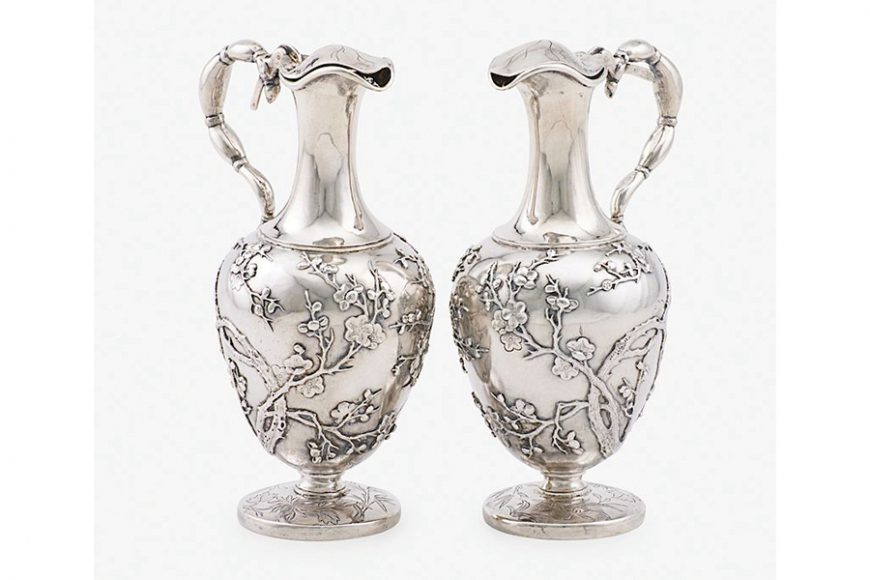Chinese export silver — silver made in China between the 18th and 20th centuries — remains one of my longest-held passions as a silver specialist. My first encounter with the material was a family heirloom. Adorning our dining table at every major occasion was a large silver centerpiece. The base was set with elaborately plumed birds traversing a root and rockwork ground, with the stem fashioned as paired columns of bamboo stalks, all supporting a central bowl pierced with bamboo leaves. Having grown up with the relative sparseness of Georgian silver, my eye didn’t know where to look. I’d never seen anything like it and I’ve been a fan ever since.
The passion for this material is far from mine alone. What was once a niche collecting area has exploded in scope and value over the years. Much of the credit for this growing interest is due to the unflagging efforts of Adrien von Ferscht, who has produced so much new scholarship in the field.
It first attracted the attention of American scholars in the 1960s. They actually coined the term “Chinese export silver,” as it was thought that this silver was made for Westerners trading in China or stationed there and, to a lesser extent, the Persian and Indian market. The term is in itself misleading, as Von Ferscht’s research has now shown that much of this silver was acquired by domestic Chinese collectors.
The first phase of Chinese export silver dates circa 1785 to the mid-19th century, when silver was supplied largely to American and European merchants trading in Canton. During this era, Chinese export silver was made to imitate Western Georgian and Regency silver, in form, decoration and even in its marks. At first blush, a Chinese-made teapot would appear to be of English origin. Only upon closer inspection would the teapot be revealed to be uncharacteristically heavier than its English counterpart and its construction techniques varied as well. Looking closer still, the marks were imitation English, referred to as “pseudo-hallmarks.” These subtle differences, taken together, would be the tipoff that a teapot was of Chinese, not English, origin.
As there was no assay system for measuring Chinese silver, there was no obligation to mark silver objects. Accordingly, a variety of marks are found on Chinese export silver. In time, the early pseudo-hallmarks gave way to Latin names or monograms, Chinese ideograms and purity marks. These marks, represented, respectively, the name of the retailer or merchant, the name of the silversmith and the standard of silver.
Making its way to the West, early Chinese silver was later misidentified as English or American, until its Chinese origins were recognized with scholarship in the field. Until recently, it was this Chinese pseudo-English silver that garnered the highest prices at auction and was sought by Western collectors.
The second phase of Chinese silver dates from the mid-19th century onward. This silver is best be described as a hybrid, employing Western forms that are adorned with traditional Chinese motifs. In this second phase, the imitative Georgian silver gave way to a new style elaborately decorated with battle or court scenes and embellished with dragon headed-handles, spouts and finials. Among the most popular motifs were bamboo, flowering branches, prunus blossoms, cracked ice, dragons, clouds, grapes and squirrels, all common motifs in Chinese decorative art.
According to Von Ferscht, this hybrid Chinese silver appealed not only to Western merchants and traders but to a growing and increasingly affluent Chinese middle class. They were drawn to Western styles, while still appreciating the allegorical meaning of the Chinese decorations.
Today, it is this second phase of Chinese silver that has once again captured the attention of both Western and Chinese buyers. While Western collectors have focused on the Latin retailer’s mark, Chinese collectors have focused their attention on the mark of the Chinese artisan silversmith.
Tea services, mugs, standing cups and vases are among the most common Chinese export silver forms and are hotly contested if of fine quality and by an esteemed retailer or silversmith. Even obsolete forms, such as calling card cases and snuff boxes, can perform equally well at auction. As always, it is the unusual forms or pieces of grand scale that remain the most highly sought after and achieve the highest values at auction. A half century after its rediscovery, interest in the field of Chinese export silver shows no sign of abating.
Jennifer Pitman writes about the jewelry, fine art and modern design she encounters as Rago Auction’s senior account manager for Westchester County and Connecticut. For more, contact Jenny at ragoarts.com or 917-745-2730.


